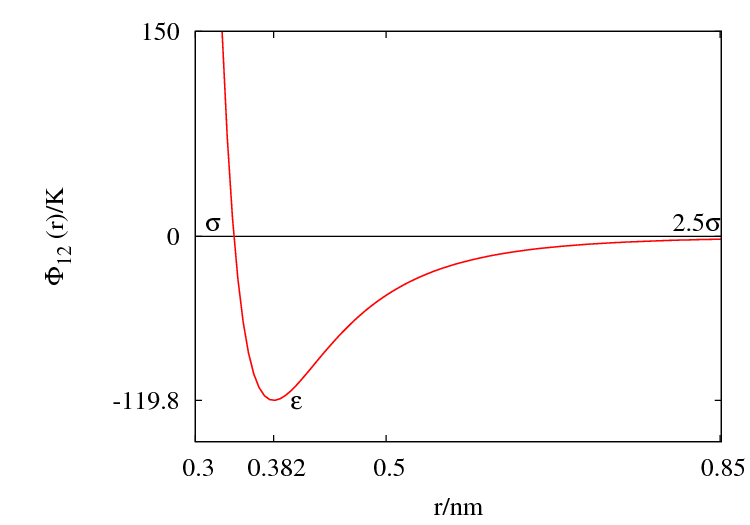Lennard-Jones model: Difference between revisions
Jump to navigation
Jump to search
| Line 38: | Line 38: | ||
== Related potential models == | == Related potential models == | ||
It is relatively common the use of potential functions given by: | |||
: <math> V (r) = c_{m,n} \epsilon \left[ \left( \frac{ \sigma }{r } \right)^m - \left( \frac{\sigma}{r} \right)^n | |||
\right]. | |||
</math> | |||
with <math> m </math> and <math> n </math> being positive integer numbers and <math> m > n </math>, and | |||
<math> c_{m,n} </math> is chosen to get the minumum value of <math> V(r) </math> being <math> V_{min} = - \epsilon </math> | |||
These forms are usually refered to as '''m-n Lennard-Jones Potential''' | |||
==References== | ==References== | ||
Revision as of 13:23, 23 March 2007
Lennard-Jones potential
The Lennard-Jones potential is given by
where:
- : potential energy of interaction between two particles at a distance r;
- : diameter (length);
- : well depth (energy)
Reduced units:
- Density, , where (number of particles divided by the volume .)
- Temperature; , where is the absolute temperature and is the Boltzmann constant
Argon
The Lennard-Jones parameters for argon are 119.8 K and 0.3405 nm. (Ref. ?)

This figure was produced using gnuplot with the command:
plot (4*120*((0.34/x)**12-(0.34/x)**6))
Features
Special points:
- Minimum value of at ;
Related potential models
It is relatively common the use of potential functions given by:
with and being positive integer numbers and , and is chosen to get the minumum value of being
These forms are usually refered to as m-n Lennard-Jones Potential
![{\displaystyle V(r)=4\epsilon \left[\left({\frac {\sigma }{r}}\right)^{12}-\left({\frac {\sigma }{r}}\right)^{6}\right]}](https://wikimedia.org/api/rest_v1/media/math/render/svg/5256ed833acfbaa9f624a55f4be3f9fcb3c27e1a)















![{\displaystyle V(r)=c_{m,n}\epsilon \left[\left({\frac {\sigma }{r}}\right)^{m}-\left({\frac {\sigma }{r}}\right)^{n}\right].}](https://wikimedia.org/api/rest_v1/media/math/render/svg/cc5ebe5f89c70f5f1a6a69f012493d816613d372)




